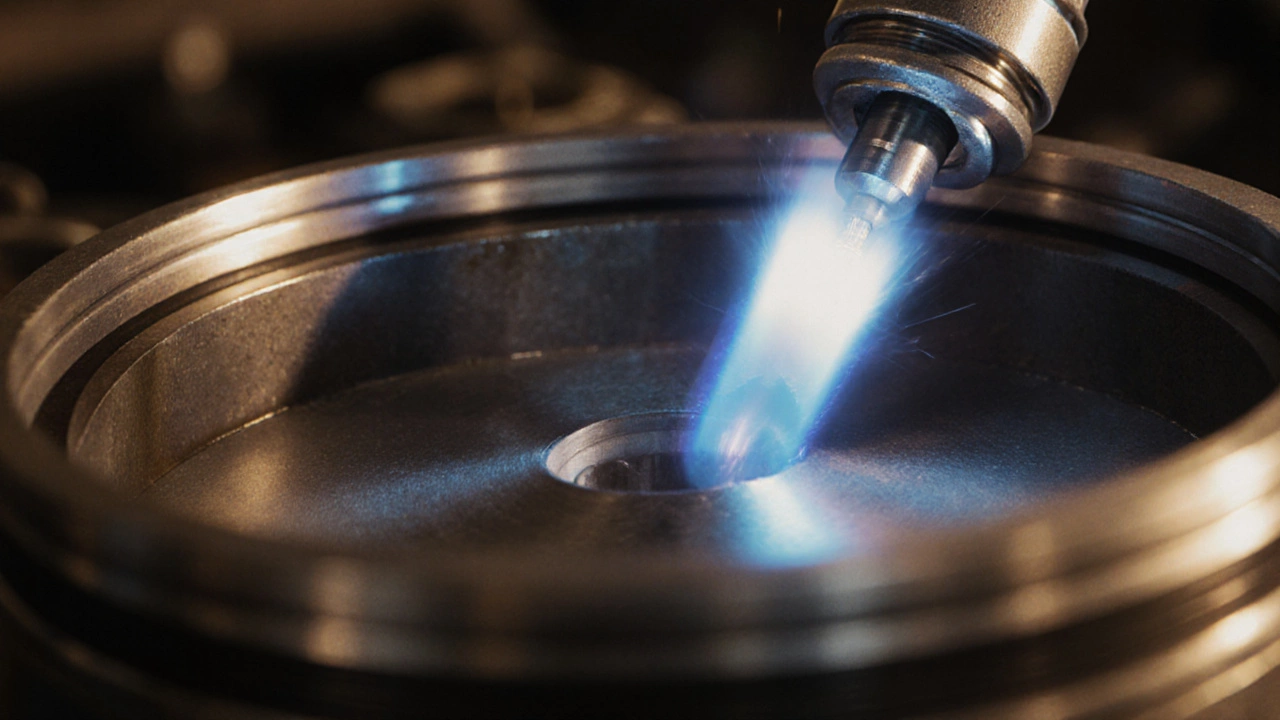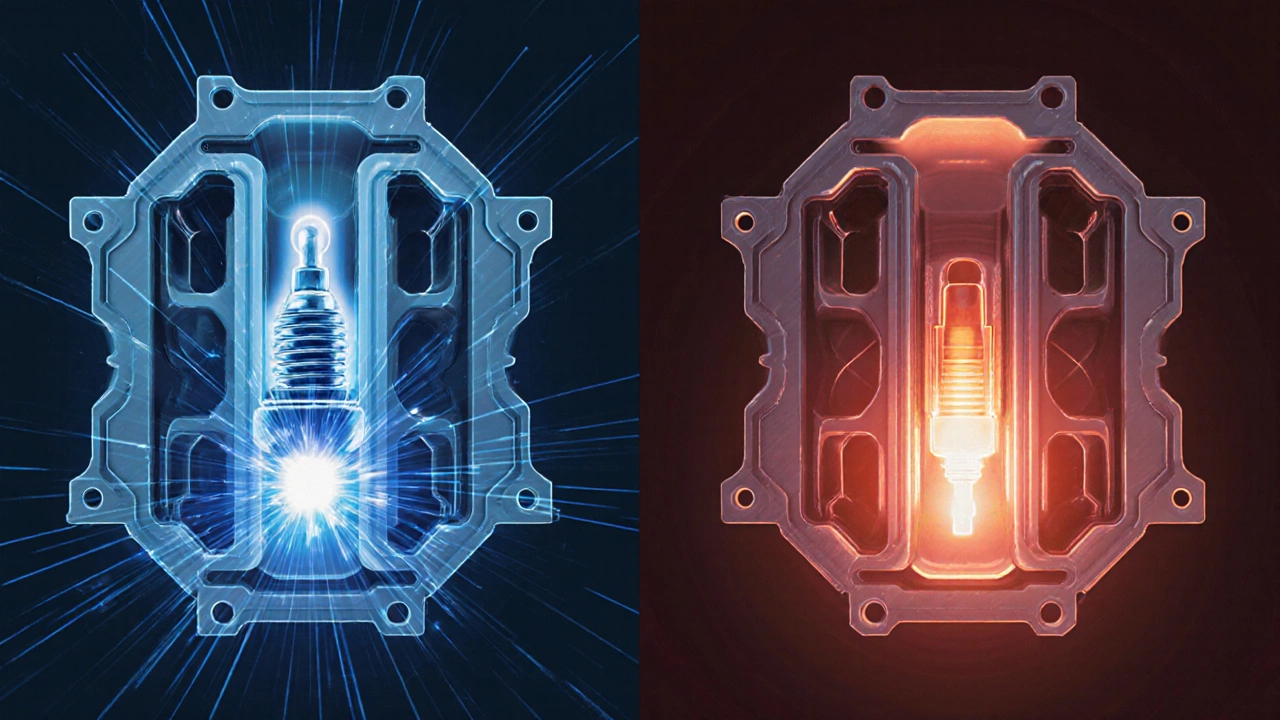Can a Car Run Without a Spark Plug? Explained
 Oct, 21 2025
Oct, 21 2025
Ever wondered whether a car could keep moving if its spark plug suddenly vanished? The short answer is: most gasoline‑powered cars will stall, but diesel engines and a few special cases can keep chugging. Below we break down how spark plugs fit into the bigger picture, when they’re truly indispensable, and what happens when they’re missing.
What a Spark Plug Actually Does
Spark Plug is a small electro‑mechanical device that delivers a high‑voltage spark to ignite the air‑fuel mixture inside a cylinder of an internal combustion engine. It sits at the top of each combustion chamber, with a metal electrode protruding into the spark gap. When the engine’s ignition coil sends a voltage pulse, the spark bridges the gap, igniting the mixture and forcing the piston down.
The timing of that spark is critical. Too early and the fuel detonates before the piston reaches top dead centre, causing knock. Too late and the engine loses power because the combustion pressure is applied when the piston is already moving up.
Why Spark Plugs Matter Most for Gasoline Engines
Gasoline Engine is a type of internal combustion engine that relies on a spark plug to ignite a premixed air‑fuel charge. The engine’s control unit (ECU) monitors sensor data-crankshaft position, coolant temperature, oxygen levels-and tells the ignition coil exactly when to fire each plug.
If a plug is missing, the cylinder can’t produce a controlled explosion. The result is a loss of power, rough idle, and often a misfire code (P030x). In a four‑cylinder car, losing one plug can drop output by up to 25 % and may cause the engine to stall under load.
Modern gasoline engines use multi‑point injection, meaning each cylinder gets its own plug. That redundancy makes the engine highly sensitive to any plug failure.
Diesel Engines: No Spark Plug, No Problem?
Diesel powerplants work differently. Diesel Engine is a type of internal combustion engine that ignites fuel by compressing air to a temperature high enough to cause spontaneous combustion. Because the air temperature can exceed 800 °C during compression, diesel fuel auto‑ignites without any spark.
Instead of spark plugs, diesels use Glow Plug is a heating element that pre‑warms the combustion chamber during cold‑start conditions. Once the engine is warm, the glow plugs turn off and the engine runs solely on compression ignition.
So, if you yank out a spark plug from a diesel car, nothing happens-the engine never relied on it in the first place.
Special Scenarios Where a Car Can Still Run Without a Spark Plug
- Cold‑start aid: In some older gasoline engines, a device called a “magneto” can generate a spark independent of the coil, allowing a brief run until the main ignition system recovers.
- Push‑start: A vehicle with a manual transmission can be push‑started, using the starter motor to spin the engine fast enough that a weak spark (even from a damaged coil) may ignite the mixture.
- Alternative ignition sources: Certain performance builds replace traditional plugs with “laser ignition” or “plasma ignition” systems, which create a spark‑like discharge without a conventional plug.
- Engine control unit (ECU) overrides: Some modern ECUs can detect a plug‑out condition and temporarily retard timing on the remaining cylinders, keeping the engine alive at reduced power.
These tricks are rare, require specific hardware, and usually result in decreased performance or higher emissions. For most daily drivers, a missing plug equals a stalled engine.
Diagnosing a Missing or Faulty Spark Plug
- Check the engine light. A misfire code (P0300‑P0304) signals one or more cylinders aren’t firing.
- Listen for a ticking or popping sound that often accompanies a loose plug.
- Remove the spark plug wire and inspect the boot for damage or a broken connector.
- Use a spark plug socket to pull each plug. A missing plug will be obvious; a damaged one may show carbon fouling or cracked insulator.
- Measure coil voltage with a multimeter. Low voltage can indicate a coil failure that mimics a plug problem.
If you discover a plug is gone, replace it immediately. A single missing plug can cause fuel wastage, increased exhaust emissions, and potential damage to the catalytic converter.

What to Do If a Spark Plug Fails While Driving
- Stay calm: Reduce throttle to minimise load on the affected cylinder.
- Coast to a safe spot: If the engine starts to stumble, pull over and let it idle. A rough idle usually means the ECU is compensating.
- Inspect after stopping: Pop the hood, locate the problematic cylinder (often indicated by the Misfire code), and check the plug.
- Use a spare plug if you have one: Many car owners keep a spare of the correct heat range and gap.
- Call for assistance: If you’re unsure or the car refuses to start, a roadside service can replace the plug on the spot.
Driving for extended periods with a bad plug can overheat the cylinder, leading to piston scuffing or valve damage, so prompt attention is essential.
Comparison: Ignition Requirements for Gasoline vs Diesel Engines
| Component | Gasoline Engine | Diesel Engine |
|---|---|---|
| Primary ignition source | Spark plug | Compression ignition |
| Cold‑start aid | Heated plug (rare) | Glow plug |
| Typical voltage | 12‑30 kV | None (air compression) |
| ECU involvement | Ignition timing control | Fuel injection timing control |
| Effect of missing component | Engine misfire, stall | Usually none (if glow plug missing, cold‑start difficulty only) |
Common Myths About Running Without Spark Plugs
Myth 1: “You can run a gasoline car forever without any spark plugs if you keep the RPM low.”
Reality: Even at idle, each cylinder needs a spark to complete the combustion cycle. Without it, the cylinder just compresses air and fuel, wasting energy and eventually flooding the engine.
Myth 2: “Diesel cars use spark plugs for start‑up, so they’re essential.”
Reality: Diesel engines rely on glow plugs only for warming the air during cold starts. Once the engine reaches operating temperature, they’re idle, and the engine runs perfectly without any spark plugs.
Myth 3: “You can replace a spark plug with a higher‑heat plug to avoid misfires.”
Reality: Heat range must match the engine’s design. A too‑hot plug can cause pre‑ignition, while a too‑cold plug can foul quickly, leading to the exact misfire you’re trying to prevent.
How to Choose the Right Spark Plug for Your Car
- Heat range: Follow the manufacturer’s recommendation; usually printed on the owner’s manual or a sticker under the hood.
- Gap setting: Use a feeler gauge to set the gap to the exact specification (often 0.8‑1.2 mm).
- Electrode material: Copper offers excellent conductivity but wears faster; iridium lasts longer and works well in high‑performance engines.
- Thread size: Most passenger cars use M8×1.25; verify before buying.
Installing the correct plug ensures reliable ignition, better fuel economy, and lower emissions.
Bottom Line: Can a Car Run Without a Spark Plug?
For a typical gasoline‑powered vehicle, the answer is a firm “no” - the engine will misfire, lose power, and eventually stall. Diesel engines, on the other hand, don’t need spark plugs at all, and certain niche ignition technologies can keep a gasoline engine running under very specific conditions. The safest bet is to keep your spark plugs in good shape, replace them on schedule, and address any misfire codes promptly.

What happens if a spark plug falls out while driving?
The cylinder with the missing plug will no longer fire, causing a noticeable loss of power, rough idle, and often a misfire code. The engine may continue to run on the remaining cylinders, but performance drops sharply and fuel consumption rises.
Do diesel engines ever use spark plugs?
No. Diesel engines ignite fuel through compression alone. They employ glow plugs only during cold starts to warm the combustion chamber; the engine operates without any spark once it’s up to temperature.
Can I drive a gasoline car with one faulty spark plug?
You can, but expect up to 20‑30 % power loss, increased fuel use, and potential engine damage if the faulty plug fouls the catalyst. It’s best to replace the plug before any long trips.
How often should I replace my spark plugs?
Most manufacturers suggest every 30,000-100,000 km depending on plug material. Iridium plugs can last up to 120,000 km, while copper plugs may need replacement at 30,000 km.
Is it safe to use a spark plug with a different heat range?
No. Using the wrong heat range can cause pre‑ignition or fouling, both of which harm engine performance and longevity.